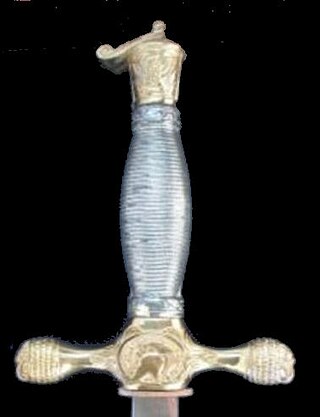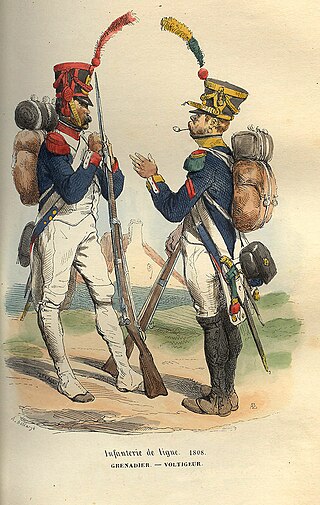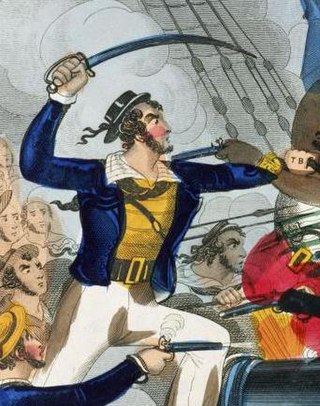A sword is an edged, bladed weapon intended for manual cutting or thrusting. Its blade, longer than a knife or dagger, is attached to a hilt and can be straight or curved. A thrusting sword tends to have a straighter blade with a pointed tip. A slashing sword is more likely to be curved and to have a sharpened cutting edge on one or both sides of the blade. Many swords are designed for both thrusting and slashing. The precise definition of a sword varies by historical epoch and geographic region.

A bayonet is a knife, dagger, sword, or spike-shaped weapon designed to fit on the end of the muzzle of a rifle, carbine, musket or similar firearm, allowing it to be used as a spear-like weapon. From the early 17th to the early 20th century, it was a weapon for infantry attacks. Today it is considered an ancillary weapon or a weapon of last resort, although it is still used for ceremonial purposes.

The small sword or smallsword is a light one-handed sword designed for thrusting which evolved out of the longer and heavier rapier of the late Renaissance. The height of the small sword's popularity was between mid 17th and late 18th century, when any man, civilian or military, with pretensions to gentlemanly status would have worn a small sword on a daily basis.

The shashka or shasqua is a kind of sabre; a single-edged, single-handed, and guardless backsword. The comparatively subtle curve of a shashka blade puts the weapon midway between a typically curved sabre and a straight sword, effective for both cutting and thrusting.

The Pattern 1908 cavalry trooper's sword was the last service sword issued to the cavalry of the British Army. It has been called the most effective cavalry sword ever designed, although its introduction occurred as swords finally became obsolete as military weapons. In use, it, like other thrust-based cavalry swords, is best described as a one-handed lance, due to its complete lack of utility for anything but the charge. In fact, the closely related US Model 1913 Cavalry Saber was issued with only a saddle scabbard, as it was not considered to be of much use to a dismounted cavalryman. Colonial troops, who could expect to engage in melee combat with opposing cavalry frequently carried cut and thrust swords either instead of, or in addition to, the P1908/1912.

The Model 1832 foot artillery sword was a 25-inch (64 cm) short-sword with a straight, double-edged blade and brass-mounted leather scabbard.

The gothic hilted swords were a family of swords carried by officers and some NCOs of the British Army between 1822 and the present day. They were primarily infantry swords, although they were also regulation pattern for some other officers such as surgeons and staff officers. The term "Gothic hilt" is derived from a perceived similarity between the curved bars of the guard and the arches found in Gothic architecture. They were elegant aesthetically pleasing weapons, although they were considered by some to be mediocre fighting swords. The weapon and its variants had a very long service life.
The Model 1840 light artillery saber was a saber of about 42 inches in length with a curved, single-edged blade and iron scabbard.

The Marine Corps noncommissioned officer's sword is a sword worn by noncommissioned officers (NCOs) and staff noncommissioned officers (SNCOs) of the United States Marine Corps. The NCO sword was adopted in 1859 and is patterned after the United States Army's foot officers' sword of 1850. The M1859 NCO sword continues service today as the Marine Corps drill and ceremonial sword. The sword's use is restricted by regulation to ceremonial occasions by an NCO or Staff NCO in charge of troops under arms or at weddings and wedding receptions where at least one of those being married is in uniform and has the rank of Corporal or higher.
The 1897 pattern infantry officers’ sword is a straight-bladed, three-quarter basket-hilted sword that has been the regulation sword for officers of the line infantry of the British Army from 1897 to the present day.

The Model 1860 Light Cavalry Saber is a long sword made of steel and brass, used by US cavalry from the American Civil War until the end of the Indian wars; some were still in use during the Spanish–American War. It was 41 inches (104 cm) long with a 35 by 1 in blade and weighed 2 lb 4 oz (1.0 kg) alone or 3 lb 10 oz (1.6 kg) with iron scabbard.

The Pattern 1796 heavy cavalry sword was the sword used by the British heavy cavalry, and King's German Legion Dragoons, through most of the period of the Revolutionary and Napoleonic Wars. It played an especially notable role, in the hands of British cavalrymen, at the battles of Salamanca and Waterloo. The pattern was adopted by Sweden and was used by some Portuguese cavalry.

The guntō was a ceremonial sword produced for the Imperial Japanese army and navy after the introduction of conscription in 1872.

The West Point Cadets' Sword is issued to cadet officers of the United States Military Academy at West Point, New York for wear when the uniform is designated as "under arms," to include formal functions, drill, parades, inspections and graduation. The swords are issued to cadets in their First Class (4th) year, and are returned to the Academy upon separation, although Cadets have the option of buying their saber or purchasing a newly made one. Despite its straight blade and lack of a knuckle guard, it is referred to by USMA staff and cadets as a "saber," likely because the commands for its manual of arms utilize that term as the command of execution
The military uniforms of the Union Army in the American Civil War were widely varied and, due to limitations on supply of wool and other materials, based on availability and cost of materials. The ideal uniform was prescribed as a dark blue coat with lighter pants, with a black hat. Officer's ranks were denoted with increasing levels of golden decoration. Specific jobs, companies, and units had markedly different styles at times, often following European customs such as that of the Zouaves. Officers uniforms tended to be highly customized and would stray from Army standard. Ironically, several main pieces of gear had been created by order of the U.S. War Secretary Jefferson Davis before the war; he later became Confederate President.

The M3 trench knife or M3 fighting knife was an American military combat knife first issued in March 1943. The M3 was originally designated for issue to soldiers, not otherwise equipped with a bayonet. However, it was particularly designed for use by forces in need of a close combat knife, such as Airborne Units and Army Rangers, so these units received priority for the M3 at the start of production. As more M3 knives became available in 1943 and 1944, the knife was issued to other soldiers such as Army Air Corps crewmen and soldiers not otherwise equipped with a bayonet, including soldiers issued the M1 carbine or a submachine gun such as the M3 submachine gun "grease gun".

In military uniforms, a shoulder belt is a wide belt worn usually over the shoulder and across the body. With nearly all line infantry, skirmishers, light infantry, grenadiers and guard regiments, two shoulder belts were worn - one carrying the cartridge box, and another for the bayonet, a sword, or other military equipment.
The Imperial and Royal Infantry was an arm of the Common Army of the Austro-Hungarian monarchy and comprised two elements:
The Pattern 1831 sabre for General Officers is a British army pattern sword prescribed for the use of officers of the rank of major-general and above. It has been in continuous use from 1831 to the present. It is an example of a type of sword described as a mameluke sabre.

Ratings of the Royal Navy have used cutlasses, short, wide bladed swords, since the early 18th century. These were originally of non-uniform design but the 1804 Pattern, the first Navy-issue standard cutlass, was introduced at the start of the 19th century. This was a bluntish weapon that was perhaps intended for cutting away canvas and ropes rather than as a thrusting combat weapon. The 1845 Pattern cutlass introduced a bowl-style hand guard which provided greater protection, with a longer and more curved blade. Its sharper point made it more useful for thrusting attacks, which were now emphasised in the drill manual. The 1845 Pattern was modified several times including shortening and straightening the blades, which weakened them. The 1889 Pattern had a straight, spear-pointed blade with a hilt that curved outwards to catch and redirect an opponent's sword point. The 1900 Pattern, the last navy-issue cutlass, was similar to its predecessor with the introduction of a fuller and a hilt insert that cushioned the user's little finger. The cutlass was withdrawn from service in 1936 but remains in use for ceremonial purposes. It is thought that it was last used in combat in 1900 during the Boxer Rebellion.














